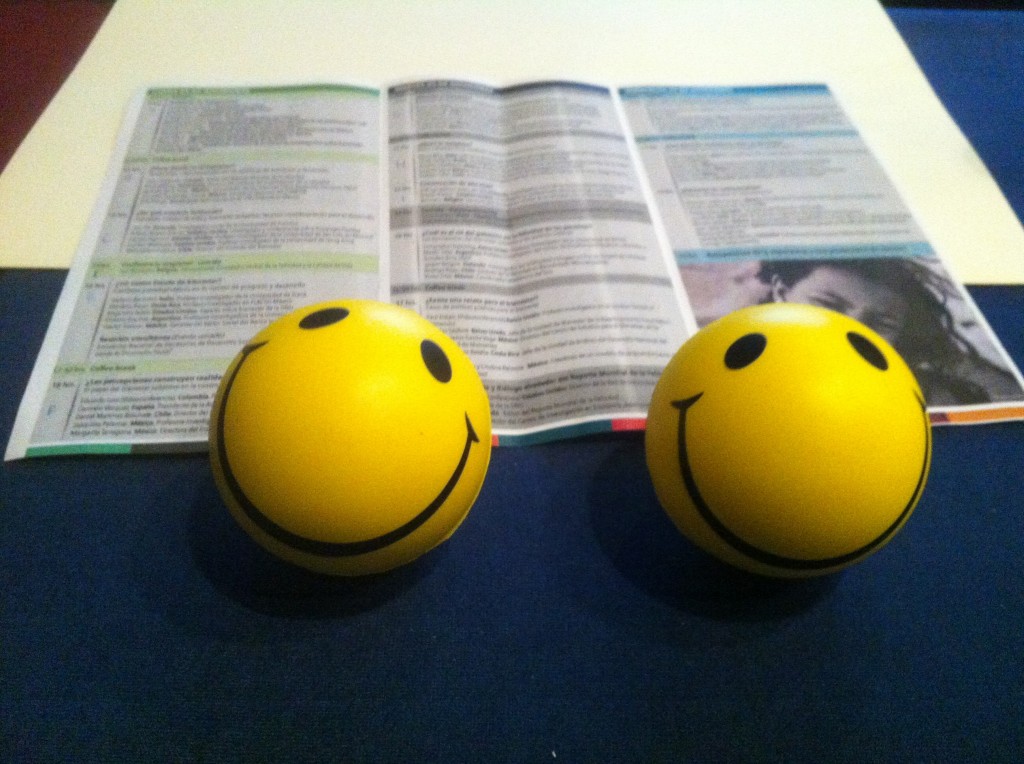What serious message can a tiny, bright yellow, stress ball with a smiley convey?
Last week I shared a couple of lessons I learnt from other speakers at the well-being and development conference in Guadalajara. Today, I wanted to tell you about the points of my own presentation.
Juggling a yellow stress ball
The panel I was on had the title ‘what is the role of governments in happiness of the people? I used this little yellow ball to illustrate my message. I realised that many participants were triggered by these little balls in their welcome pack. Some people took pictures of them, holding them in front of their face or their bag and tweeted them. Probably, others just left them in a corner or threw them away. And myself, I decided to juggle with them at the beginning of my speech.
Is there a message in (very poorly!) juggling with stress balls?
I argued there was. My point was simply: everybody will use tools you give them in a different way. You can bring a horse to the stream, but you can’t force it to drink. Sometimes a horse just wants to splash the water!
It’s the same with public policies: as a government you can design policies that you hope make people happier, but you can’t control how they will react. Still, I think there is large responsibility for governments to create the underlying conditions in which citizens can strive. Long-term well-being and quality of life combine subjective elements (our emotions, how we react to circumstances) and objective elements (the environment we live in). This environment is partly shaped by governments’ economic, environmental and social policies. If good or bad choices are made, that will ultimately influence the quality of our lives.
In the speech, I tried to give my own ‘little stress balls’, or methods to enhance quality of life. I made three suggestions to the policy makers in the room:
Integrated measurements of well-being
Firstly, I advised them to carefully measure the well-being in their jurisdiction. Well-being indicators from all areas – economy, environment, social affairs, health, education, and others – should be measured together, rather than in isolation. Now, in most countries, GDP is the main metric that is used in public policy. I argue that a dashboard of several indicators, such as in the OECD’s Better Life Index, is a good tool to have an additional layer of information. As such, policy makers can detect in which area improved policy outcomes can win the most in terms of quality of life. This can help them to focus their resources on the areas where they can make the biggest difference.
 Treat well-being as a political agenda
Treat well-being as a political agenda
Secondly, I suggested to treat well-being as a political agenda like any other. If the focus will be more on quality of life and well-being, and less on purely economic growth, that is a massive shift in policy! Administrations know that they have to communicate all their policies to citizens and engage in a public debate to explain the choices the made. This applies to well-being just the same as to other areas.
It starts with happiness at work
Thirdly, I advised to also look at the happiness at work of staff in the administration. Motivation and job satisfaction at an individual and team level massively affect the success that an administration will have in the implementation of it its policies. Surveys can be used to monitor and improve work satisfaction and working conditions of the staff responsible to deliver the well-being policy objectives set by politicians and policy makers. Only happy staff can create happy citizens.
Now it is to the administration of Jalisco to translate the lessons from me, and all other speakers, into new and better policies. To be continued!
(and next week, I’ll face one of the other questions debated on the conference: why are Mexicans so happy?)

